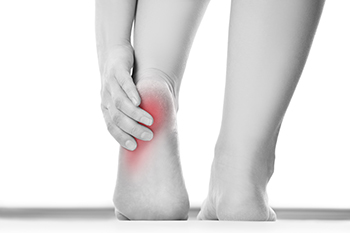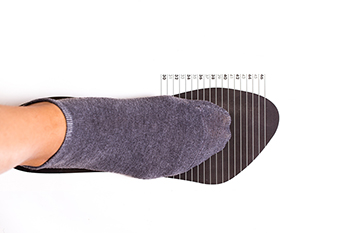Items filtered by date: July 2023
Common Causes of Ankle Pain

The ankle joint is a complex combination of bones, muscles, ligaments, tendons, and nerves. For that reason, there are many causes of ankle pain. The most common is a sprain, which happens when a ligament is stretched beyond its normal range and tears or ruptures. Another cause of ankle pain is stress fractures, which are hairline cracks in the bones that are caused by the type of repetitive pounding that occurs while running or playing sports. Other causes of ankle pain include arthritis, gout, and Achilles tendonitis. Gout is an inflammatory condition related to the overabundance of uric acid in the body. Crystals can form within the ankle joint and cause extreme pain. Achilles tendonitis is largely the result of overuse in the tendon that attaches the calf muscles to the heel. Resting the ankle is the first on the treatment list, but if bearing weight on the injured foot is difficult or impossible, it is suggested that you consult a chiropodist for help.
Ankle pain is a common symptom of many lower limb problems. If you are experiencing ankle pain, please consult with one of the chiropodists from Complete Family Footcare & Therapy. Our clinicians will assess your condition and provide you with quality foot and ankle treatment.
The ankle is composed of a number of muscles, bones, tendons, and ligaments. There are many conditions which may cause ankle pain.
Causes
-
Ankle strains or sprains
-
Achilles tendon injuries
-
Fractures
-
Bursitis
-
Arthritis
-
Gout
-
Tarsal tunnel syndrome
Symptoms
If you have ankle pain, you may also experience a variety of other symptoms depending on the underlying cause of the pain. Some of these symptoms may include ankle swelling, bruising, redness, numbness or tingling, instability, and difficulty walking.
Diagnosis
The underlying cause of ankle pain can be diagnosed by a chiropodist. Diagnoses are typically made based on your medical history, a physical examination of the affected ankle, and imaging studies such as X-rays.
Treatment
Treatment for your ankle pain will depend on its underlying cause. Often, the chiropodist will recommend that you rest the affected ankle. You might also need to ice, compress, and elevate the ankle, wear an orthotic device, or take medications to reduce pain and inflammation.
If you have any questions, please feel free to contact our offices located in . We offer the newest diagnostic and treatment technologies for all your foot care needs.
Causes of Heel Pain

The most common cause of heel pain is plantar fasciitis, an inflammation of a wide band of tissue on the sole of the foot. This tissue, which is termed the plantar fascia, connects the toes to the heel bone. When the plantar fascia is overused, such as from running or standing for long periods of time, it can gradually tear. This causes both pain and inflammation that is felt mostly in the arch and heel. Treatment of plantar fasciitis includes resting the foot, practicing certain stretching exercises, and wearing well-fitting shoes with ample cushioning and support. Many people also wear orthotics, or shoe inserts, that can be custom-made for your particular foot. Less common causes of heel pain include stress fractures, bursitis, tarsal tunnel syndrome, and fat pad atrophy. Being overweight, wearing flat sandals or flip flops, or having a job that calls for standing for long periods are other causes of heel pain. If heel pain plagues you, it is suggested that you make an appointment with a chiropodist for an examination and diagnosis of the cause. Treatment options can vary according to the cause of the pain.
Heel pain is a common problem that can be caused by a variety of injuries, medical conditions, and other factors. If you suffer from heel pain, please consult with one of the chiropodists from Complete Family Footcare & Therapy. Our clinicians can help you maintain the health of your lower limbs and your mobility.
When it comes to heel pain, the exact location and type of pain are important to note. Some of the conditions that may cause heel pain include:
-
Plantar fasciitis - An inflammation of the ligament that runs along the bottom of the foot; it causes a stabbing pain under the heel that is at its worst when taking your first few steps after a long rest and while standing on your tiptoes or climbing stairs
-
Achilles tendonitis - An inflammation of the tendon in the back of the calf; it causes pain in the back of the heel that is at its worst after resting, as well as ankle and calf stiffness, swelling, and tenderness
-
Bone spurs - Bony lumps on the back of the heel bones that cause sharp pain upon first standing up; the pain becomes dull and achy over time
-
Heel fractures - A break or crack in the heel bone that causes pain, swelling, and difficulty walking
-
Retrocalcaneal bursitis - Swelling of the small, fluid-filled sac at the back of the heel bone; it causes pain, swelling, redness, and warmth in the back of the heel
-
Tarsal tunnel syndrome - Compression of the posterior tibial nerve which causes a pins and needles sensation in the heel, foot, and calf
Your chiropodist will be able to diagnose the underlying cause of your pain and prescribe the right treatments for you. If you have any questions, please feel free to contact our offices located in . We offer the newest diagnostic and treatment technologies for all your foot care needs.
The Importance of Well-Fitting Shoes

Ill-fitting shoes can cause a host of foot problems. It is a good idea to try on shoes in person and later in the day when the feet are at their largest. It is advised to bring the socks and insoles that will be worn with the shoes being considered. It is important to measure the feet each time new shoes are purchased, as a slight change in foot size can make all the difference in the world regarding foot comfort. It is beneficial to take foot measurements while standing and that include the length and width of the foot. If one foot is slightly larger than the other, it is best to purchase the larger shoe size. Pads can be inserted into the shoe that is worn on the smaller foot to fill any extra space. If the feet are substantially different sizes, shoes of different sizes can be purchased, if possible. Importantly, there should be approximately a half inch between the end of the longest toe and the front of the shoe, with an eighth of an inch at the back of the shoe. Toes should be able to move within the toe box of the shoes being purchased. Shoes that do not have this room can cause friction on the feet, possibly leading to irritation. It is helpful to walk around the store in both shoes, and a break-in period for new shoes should not be required. If you have existing foot problems and need help with finding shoes that fit properly, it is suggested that you consult with a chiropodist who can evaluate your feet and provide recommendations.
Finding the right shoes for you can ensure your comfort and help maintain proper foot health. If you suffer from foot pain and need help finding the right shoes for you, please consult with one of the chiropodists from Complete Family Footcare & Therapy. Our clinicians will assess your condition and provide you with quality foot and ankle treatment.
Tips to Find Great Shoes
Finding shoes that are well-fitting, supportive, and comfortable can be key in maintaining your overall foot health, but can sometimes seem like a monumental task.
Here are some tips and tricks to keep in mind when shopping for shoes.
-
Shop in a brick and mortar store - Your shoe size can change throughout your lifetime. You will be able to try on shoes before you buy them to ensure a proper fit. A salesperson can also provide recommendations on what shoes best serve your specific needs.
-
Try shoes on at the end of the day - Your feet swell throughout the day. By trying shoes on in the evening when the feet are at their largest, you ensure a good fit and shoes that are comfortable all day.
-
Have your feet measured - Find the right fit by having your feet measured at the shoe store. A salesperson can help by measuring both feet with a Brannock device to determine your true size.
-
Opt for comfort and support - Some shoes, such as high heels and flip flops, may look great but can cause damage to the feet over time. Look for shoes that have a low heel, adequate arch support, a wide toe box, and are made of breathable materials.
If you have any questions, please feel free to contact our offices located in . We offer the newest diagnostic and treatment technologies for all your foot care needs.
Gout Pain Can Be Managed
Protecting Your Feet on the Job

Certain jobs make protecting your feet an ongoing concern, and one way to do that is by wearing shoes that help to guard against injury. Experts recommend that workers in places where chemicals are stored wear closed-toed shoes at all times. Similarly, anyone who works in laboratories or places where mechanical activities are common should avoid wearing sandals, cloth sneakers, or any type of open-toed footwear. Chemical-resistant overshoes or boots are suggested for workers who may come into contact with corrosive chemical spills or other solvents that may seep into the sole of normal types of shoes. Leather shoes may absorb chemicals and be disposed of if contaminated. Wearing steel-toed shoes may be needed if there is a risk of heavy objects falling on or rolling over the feet. The toe cap should cover the entire toe area from the tips to the natural bend in the foot. A steel midsole of a work shoe can help to guard against penetration from sharp objects on the floor, but the shoe be flexible enough for the sole to bend. For more information about ways to protect your feet while in the workplace, it is suggested that you make an appointment with a chiropodist.
If you stand all day, you may be at an increased risk of developing various foot conditions. If you are experiencing foot pain of any kind, please consult with one of the chiropodists from Complete Family Footcare & Therapy. Our clinicians will assess your condition and provide you with quality foot and ankle treatment.
What Foot Problems Are Caused by Standing?
Standing all day at work may increase your risk of developing foot or ankle problems.
Some common foot conditions that may arise from spending all day on your feet include:
-
Foot pain
-
Blisters
-
Corns and calluses
-
Arthritis
-
Flat feet
-
Bunions
-
Sprains
-
Athlete’s foot
Prevention
If you stand for prolonged periods of time for work, taking preventative measures to preserve the health of your feet is strongly recommended.
Measures you can implement to help prevent foot problems include:
-
Wearing shoes that are comfortable and fit well - these shoes should be made of breathable materials and provide you with arch support and cushioning. It is best to avoid shoes that have heels or narrow toe boxes.
-
Taking breaks to rest, walk, and stretch your feet throughout the day
-
Maintaining good foot hygiene - wash and dry your feet thoroughly every day
If you have any questions, please feel free to contact our offices located in . We offer the newest diagnostic and treatment technologies for all your foot care needs.

